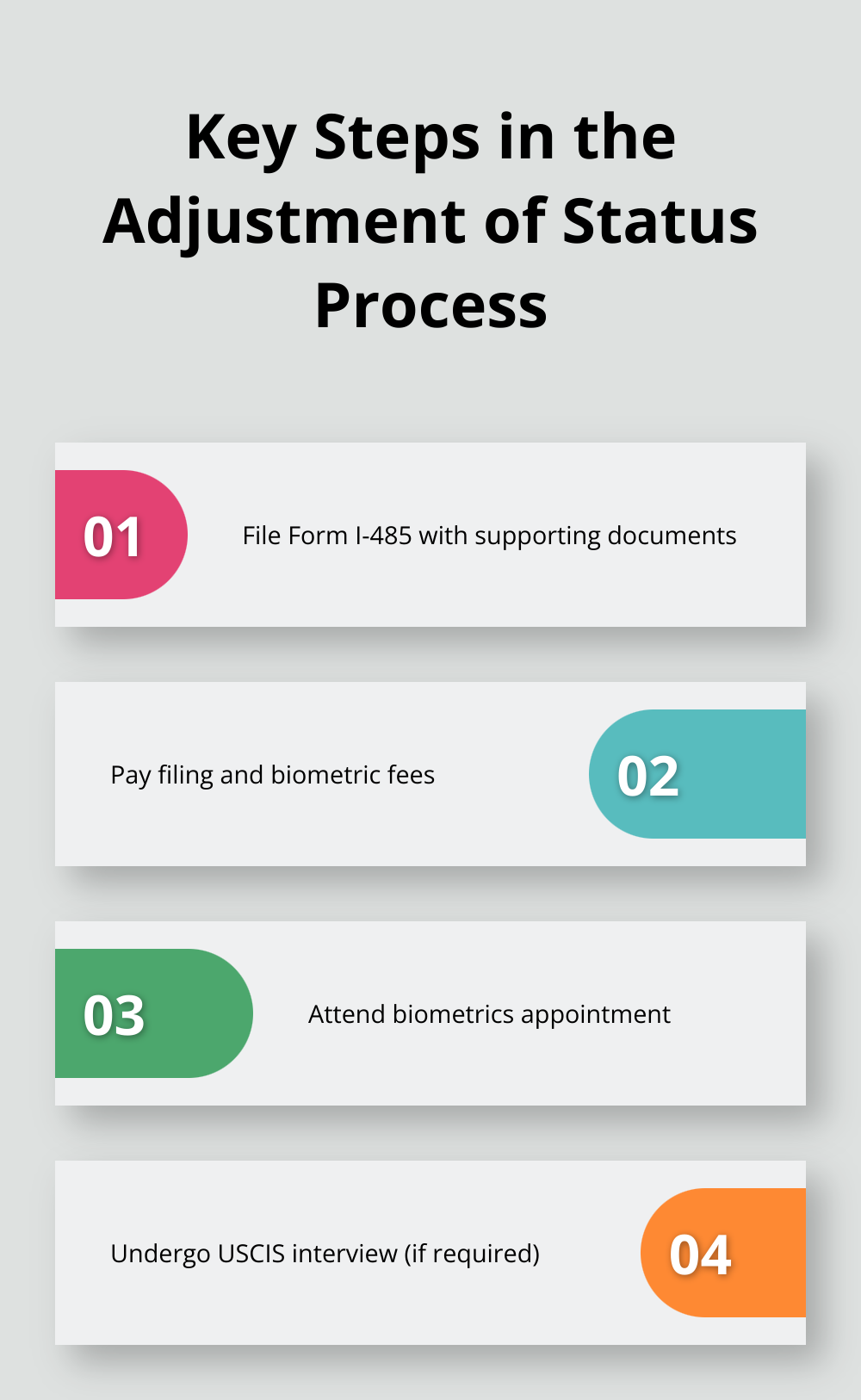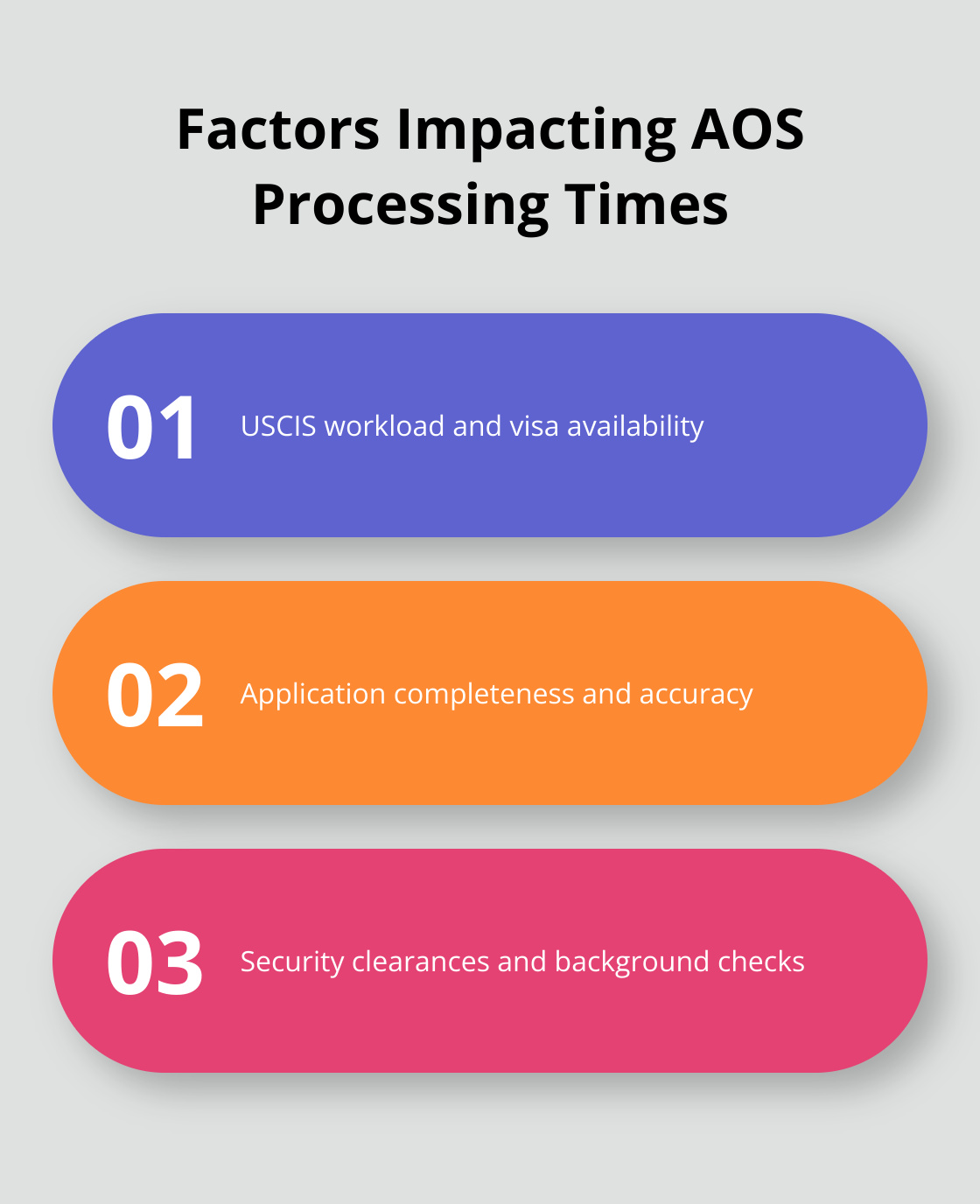
How Long Does Adjustment of Status Take in 2024?
At Law Offices of Jeffrey A. Thompson, we understand the importance of knowing the adjustment of status processing time in 2024. Many immigrants eagerly await this crucial step in their journey to permanent residency.
In this post, we’ll break down the factors affecting processing times and provide current estimates for different application types. We’ll also share tips to help streamline your adjustment of status process.
What is Adjustment of Status?
Definition and Purpose
Adjustment of status is the process that you can use to apply for lawful permanent resident status (also known as applying for a Green Card) when you are present in the United States. AOS transforms a temporary immigration status into a permanent one, granting individuals the right to live and work in the U.S. indefinitely.
Eligibility Criteria
AOS eligibility is not universal. Applicants must meet specific criteria to qualify. Generally, individuals must be physically present in the U.S. and have maintained lawful status. Common eligible groups include:
- Immediate relatives of U.S. citizens
- Employment-based immigrants with approved petitions
- Diversity visa lottery winners
Certain factors can disqualify an individual from AOS. These include criminal convictions, visa overstays, and unauthorized employment.
The Application Process
The AOS process involves several key steps:

Processing Times and Considerations
AOS processing times vary significantly based on factors such as application type and USCIS workload. For all family-sponsored preference categories, you must use the Dates for Filing chart in the Department of State Visa Bulletin for May 2025.
Applicants must maintain valid status throughout the AOS process. This often means renewing underlying visas or obtaining work and travel permits (EAD/AP) while the AOS is pending.
Understanding the AOS process is essential, but equally important is recognizing the factors that can affect processing times. Let’s explore these factors in more detail to gain a comprehensive view of the AOS timeline in 2024.
What Impacts AOS Processing Times?
The duration of the Adjustment of Status (AOS) process can vary significantly from case to case. Several key factors influence how long it takes for an application to be processed and approved. Understanding these elements can help applicants set realistic expectations and take steps to potentially expedite their cases.

USCIS Workload and Visa Availability
One of the primary factors affecting AOS processing times is the current workload at U.S. Citizenship and Immigration Services (USCIS). As of April 2025, USCIS experiences significant backlogs in certain visa categories. Currently, the agency’s publicly posted processing times show the amount of time it took USCIS to complete 80% of adjudicated cases over the past six months.
The availability of visas in your category also plays a crucial role. Employment-based preference categories, for example, must use the Final Action Dates chart for adjustment applications. This means that even if your I-485 is ready for processing, you may need to wait until a visa becomes available in your category.
Application Completeness and Accuracy
The thoroughness and accuracy of your AOS application can significantly impact processing times. Incomplete or inaccurate applications often result in Requests for Evidence (RFEs) from USCIS, which can add months to the process. In 2024, RFEs were the leading cause of delays in AOS cases.
To minimize the risk of delays, include all required documents and fill them out properly. Pay close attention to details such as dates, names, and addresses. If you’re unsure about any aspect of the application, consult with an experienced immigration attorney (such as those at Law Offices of Jeffrey A. Thompson).
Security Clearances and Background Checks
Every AOS applicant undergoes security clearances and background checks as part of the process. The duration of these checks can vary based on factors such as your country of origin, travel history, and personal background. In some cases, extensive background checks can add significant time to the overall processing period.
It’s important to note that there’s little an applicant can do to expedite this part of the process. However, be prepared with accurate information about your background and promptly respond to any inquiries from USCIS to help ensure this stage proceeds as smoothly as possible.
Regional Variations
Processing times can differ based on the USCIS office handling the application. Smaller offices may have faster processing times due to lower caseloads.
Policy Changes and Immigration Trends
Changes in immigration policies and trends can significantly influence AOS processing times. The employment-based (EB) annual limit for fiscal year (FY) 2025 will be higher than was typical before the pandemic, though lower than in FY 2021-2024.
As we move forward, let’s examine the current processing times for different types of AOS cases in 2024, providing you with a clearer picture of what to expect during your immigration journey.
How Long Does AOS Take in 2024?
Family-Based AOS Processing Times
As of April 2025, family-based AOS applications take longer to process compared to previous years. The USCIS provides data on the number of forms received, processed, approved, denied, and pending by month, along with the average processing time. Family preference categories can extend beyond a year.
These processing times represent averages, and individual cases may deviate (shorter or longer) based on specific circumstances. Applicants should check the USCIS website frequently for the most current processing times for their category and field office.

Employment-Based AOS Processing Times
Employment-based AOS applications process faster than family-based cases. The USCIS provides historical national median processing times in months for all USCIS offices for select forms by fiscal year. However, this varies depending on the specific employment-based preference category.
EB-1 (priority workers) and EB-2 (professionals with advanced degrees) categories often see faster processing times compared to EB-3 (skilled workers and professionals) or EB-4 (special immigrants) categories.
Regional Variations in Processing Times
Processing times differ significantly based on the USCIS field office handling the application. As of April 2025, the New York City field office has longer processing times compared to the Denver field office for many AOS categories.
Applicants can check processing times for their specific field office on the USCIS website. This information proves valuable when estimating wait times and deciding whether to consider options like changing the interview location (if possible).
Impact of COVID-19 on Processing Times
The COVID-19 pandemic continues to affect AOS processing times in 2024. While USCIS has implemented measures to address backlogs, some delays persist. In-person interviews (when required) may take longer to schedule due to social distancing protocols.
Strategies to Potentially Expedite Processing
While applicants cannot control all factors affecting processing times, they can take steps to potentially speed up their cases:
- Submit a complete and accurate application (to avoid Requests for Evidence).
- Respond promptly to any USCIS requests or notices.
- Consider premium processing for eligible employment-based categories.
- Keep your address updated with USCIS to avoid missed communications.
Final Thoughts
The adjustment of status processing time in 2024 depends on various factors such as USCIS workload, visa availability, and application completeness. Family-based AOS applications typically take longer than employment-based categories. Applicants can speed up their cases by submitting accurate applications, responding promptly to USCIS communications, and keeping their address updated.
Patience and preparation are essential throughout the immigration journey. The wait can be challenging, but each step brings you closer to permanent residency. Stay informed about current processing times and policy changes by checking the USCIS website regularly.
For expert guidance through the complex AOS process, seek assistance from experienced immigration attorneys. At Law Offices of Jeffrey A. Thompson, we specialize in helping clients navigate immigration matters, from paperwork completion to overcoming legal hurdles. Our dedicated team provides compassionate and knowledgeable representation tailored to your specific needs.


